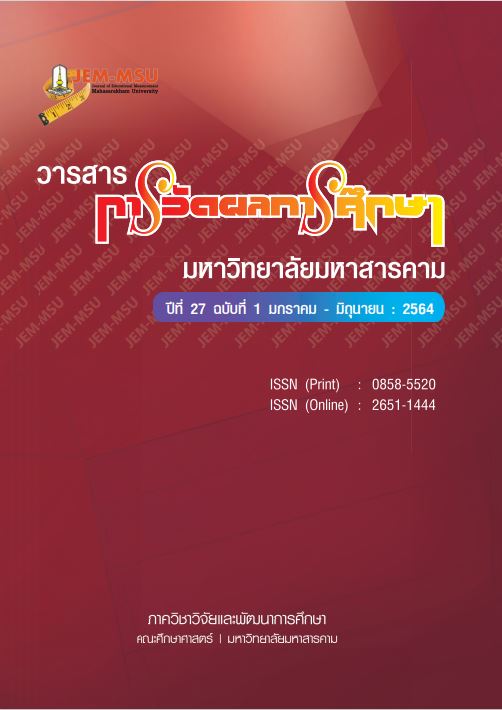Effect of Organizing Mathematics Learning Activities Using Active Learning and Diagnostic Test on Mathematics Achievement and Mathematical Problem-Solving Ability of Grade 6 Students
Main Article Content
Abstract
The research aimed to 1) construct and find the efficiency of mathematics learning activity organizing plans using active learning and diagnosis of learning deficiency which affect mathematics learning achievement and mathematical problem-solving ability of grade 6 students. The plans were constructed so as to meet the benchmark criterion of 80/80; 2) to compare the pre-learning achievement with the post-learning achievement in mathematics learning; 3) to compare the pre-learning problem-solving ability with the post-learning problem-solving ability in mathematics learning; 4) to find the effectiveness index of mathematics active learning associated with diagnosis of mathematics learning deficiency; and 5) to study the achievement motivation in learning mathematics. The sample consisted of 34 grade 6 students of Tessaban Warinwichachart School in the 1st semester of the academic year 2019, obtained through cluster random sampling. A pre-experimental design focusing on one group pretest posttest design was carried out. The research tools were: (1) mathematics learning activities organizing plans using active learning and diagnosis of mathematics learning deficiency, with a field test effectiveness value (1:100) of 81.63/81.77; (2) a mathematics achievement test with the IOC from 0.80 to 1.00, the difficulty from 0.21 to 0.79, the discrimination from 0.20 to 0.87, and the reliability of 0.82; (3) a mathematics problem solving ability test with the IOC of 1.00 for all items, the difficulty from 0.59 to 0.63, the discrimination from 0.43 to 0.55, and the reliability of 0.96; (4) 7 diagnostic tests for mathematics learning deficiency with the IOC of 1.00 for all items, the difficulty from 0.23 to 0.78, the discrimination from 0.21 to 0.84, and the reliability of all tests from 0.77 to 0.85; (5) a desirable characteristics evaluation form with the IOC of 1.00 for all items; (6) a performance observation form with the IOC of 1.00 for all items; (7) exercises for each leaning activity plan with the IOC of 1.00 for all items, the difficulty from 0.53 to 0.75, the discrimination from 0.31 to 0.69, and the reliability of 0.91; (8) 7 posttests with the IOC from 0.80 to 1.00, the difficulty from 0.21 to 0.80, the discrimination from 0.20 to 0.94, and the reliability of all tests from 0.79 to 0.88; and
(9) an achievement motivation test for learning mathematics with the IOC of 1.00 for all items, the discrimination from 0.21 to 0.91, and the reliability of 0.98. The data analysis employed percentage, the mean, standard deviation, and t-test for hypothesis testing. The findings were:
1. The efficiency of the mathematics learning activity organizing plans using active learning and diagnosis of learning deficiency which affect mathematics learning achievement and mathematical problem-solving ability of grade 6 students was 81.88/82.35.
2. The comparison of the pre-learning achievement with the post-learning achievement in mathematics learning revealed that the post-learning achievement was higher, with statistical significance at the .01 level.
3. The comparison of the pre-learning problem-solving ability with the post-learning problem solving ability in mathematics learning revealed that the post-learning problem- solving ability was higher, with statistical significance at the .01 level.
4. The effectiveness index of the mathematics learning using active learning and diagnostic test was 0.5823, indicating that the students’ knowledge had been improved at 0.5823 or 58.23%.
5. The achievement motivation in mathematics learning of grade 6 students as a whole and on each aspect was at a high level. Ranked in descending order, the top 3 aspects were as follows: enthusiasm, risk taking and ambition. Meanwhile, planning ranked the lowest.
Article Details
The content and information contained in the published article in the Journal of Educational Measurement Mahasarakham University represent the opinions and responsibilities of the authors directly. The editorial board of the journal is not necessarily in agreement with or responsible for any of the content.
The articles, data, content, images, etc. that have been published in the Journal of Educational Measurement Mahasarakham University are copyrighted by the journal. If any individual or organization wishes to reproduce or perform any actions involving the entirety or any part of the content, they must obtain written permission from the Journal of Educational Measurement Mahasarakham University.
References
กระทรวงศึกษาธิการ. (2553). หลักสูตรแกนกลางการศึกษาขั้นพื้นฐาน พุทธศักราช 2551. กรุงเทพฯ: กระทรวงศึกษาธิการ.
กิตติพันธ์ วิบุลย์ศิลป์. (2560). ผลการจัดกิจกรรมการเรียนรู้ คณิตศาสตร์ ตามแนวคิดห้องเรียน กลับด้าน ร่วมกับการเรียนรู้ เชิงรุกที่มีผลต่อความสามารถในการแก้ปัญหาคณิตศาสตร์ และความสามารถในการคิดอย่างมีวิจารณญาณของนักเรียนมัธยมศึกษาปีที่ 5. (สาขาวิชาการศึกษาคณิตศาสตร์ภาคหลักสูตรและการสอน). กรุงเทพฯ: บัณฑิตวิทยาลัย จุฬาลงกรณ์มหาวิทยาลัย
เกษมสันต์ อินพรม. (2549). การวิเคราะห์สหสัมพันธ์คาโนนิคอลระหว่างแรงจูงใจใฝ่สัมฤทธิ์กับผลสัมฤทธิ์ทางการเรียนวิชาคณิตศาสตร์และวิทยาศาสตร์ของนักเรียนชั้นมัธยมศึกษาปีที่ 3. ปริญญานิพนธ์ กศ.ม. สาขาวิชาการวิจัยและสถิติทางการศึกษา บัณฑิตวิทยาลัย มหาวิทยาลัยศรีนครินทรวิโรฒ.
ขวัญใจ สายสุวรรณ. (2554). การสร้างแบบทดสอบวินิจฉัยจุดบกพร่องในการเรียนวิชาคณิตศาสตร์ เรื่อง เลขยกกำลัง สำหรับนักเรียนชั้นมัธยมศึกษาปีที่ 1. วิทยานิพนธ์ ครุศาสตรมหาบัณฑิต สาขาวิชาวิจัยและประเมินผลการศึกษา มหาวิทยาลัยราชภัฏมหาสารคาม.
คณะกรรมการการศึกษาขั้นพื้นฐาน, สำนักงาน. (2562). แนวทางการนิเทศเพื่อพัฒนาและส่งเสริมการจัดการเรียนรู้เชิงรุก หน่วยศึกษานิเทศก์ สำนักงานคณะกรรมการการศึกษาขั้นพื้นฐาน (Active Learning) ตามนโยบายลดเวลาเรียน เพิ่มเวลารู้. กรุงเทพฯ: โรงพิมพ์ชุมนุมสหกรณ์การเกษตรแห่งประเทศไทย.
ชัยยงค์ พรหมวงศ์. (2556). การทดสอบประสิทธิภาพสื่อหรือชุดการสอน. ศิลปากรศึกษาศาสตร์วิจัย. 5(1), 7-20.
ชัยยงค์ พรหมวงศ์ และคณะ. (2521). ระบบสื่อการสอน. กรุงเทพมหานคร: โรงพิมพ์จุฬาลงกรณ์มหาวิทยาลัย.
ธนวรรณ นัยเนตร. (2560). ผลของการจัดการเรียนรู้เชิงรุกร่วมกับคำถามระดับสูงที่มีต่อความสามารถ ในการให้เหตุผลและผลสัมฤทธิ์ทางการเรียนคณิตศาสตร์เรื่อง ฟังก์ชันของนักเรียนชั้นมัธยมศึกษาปีที่ 4. วิทยานิพนธ์การศึกษามหาบัณฑิต สาขาวิชาการสอนคณิตศาสตร์ มหาวิทยาลัยบูรพา.
บุญชม ศรีสะอาด. (2523, พฤษภาคม-สิงหาคม). “แบบทดสอบวินิจฉัย,” การวัดผลการศึกษา. 2, 1 : 9-24.
ไพฑูรย์ สินลารัตน์ และคณะ. (2557). คิดนอกกรอบ : สอนและสร้างได้อย่างไร. กรุงเทพฯ: โรงพิมพ์แห่งจุฬาลงกรณ์มหาวิทยาลัย.
โรงเรียนเทศบาลวารินวิชาชาติ. (2561). รายงานการประเมินตนเอง (SAR) ปีการศึกษา 2560.
วัชรา เล่าเรียนดี. (2548). เทคนิคและยุทธวิธีพัฒนาทักษะการคิด การจัดการเรียนรู้ที่เน้นผู้เรียนเป็นสำคัญ. นครปฐม: คณะศึกษาศาสตร์ มหาวิทยาลัยศิลปากร.
วิจิตรา ทองงอก. (2545). การสร้างแบบทดสอบวินิจฉัยจุดบกพร่องในการเรียนวิชาคณิตศาสตร์ เรื่อง การแก้สมการและอสมการตัวแปรเดียว สำหรับนักเรียนชั้นมัธยมศึกษาปีที่ 4 ในเขต กรุงเทพมหานคร. ปริญญานิพนธ์ กศ.ม. สาขาวิชาการวัดผลการศึกษามหาวิทยาลัย ศรีนครินทรวิโรฒ.
ศิริเดช สุชีวะ. (2550). “การวิเคราะห์จุดอ่อนและจุดแข็งของผู้เรียน” ใน หนังสือชุดปฏิรูปการศึกษา การประเมินผลการเรียนรู้แนวใหม่. หน้า 154-176. สุวิมล ว่องวานิช, บรรณาธิการพิมพ์ ครั้งที่ 2. กรุงเทพฯ: โรงพิมพ์แห่งจุฬาลงกรณ์มหาวิทยาลัย.
สถาบันส่งเสริมการสอนวิทยาศาสตร์และเทคโนโลยี. (2555). ทักษะและกระบวนการทาง คณิตศาสตร์. กรุงเทพฯ: 3-คิว มีเดีย.
สถาบันทดสอบทางการศึกษาแห่งชาติ. (2561). [ออนไลน์]. ได้จาก https://www.niets.or.th/th/ [สืบค้นเมื่อ 20 กันยายน 2561].
สุวารี คงมั่น. (2545). การพัฒนาความสามารถในการแก้ปัญหาในชีวิตประจำวัน โดยการสอนแบบแก้ปัญหาในกลุ่มการงานพื้นฐานอาชีพ แขนงงานบ้าน ของนักเรียนชั้นประถมศึกษาปีที่ 5. วิทยานิพนธ์ศึกษาศาสตรมหาบัณฑิต มหาวิทยาลัยขอนแก่น.
Gagne, R. M. (1970). The Condition of Learning. New York : Holt, Rinchart and Winston.
Johnson, D. W.; et al. (1991). Active Learning: Cooperation in the College Classroom. Edina, Mn: Interraction Book Company.
Krulik, S. and J. A. Rudnick. (1993). Reasoning and Problem solving: A Handbook for Elementary School Teacher. Boston: Allyn and Bacon
McClelland, D.C. (1961, May). “Toward a Theory of Motive Acquisition,” American Psychologist. 20, 5: 321-333(b).
Polya. (1957). How to Solve It. 3rd ed. Garden City, New York: Doubleday.


